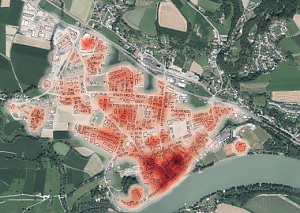ModularHeatNet
Short Description
Starting point / motivation
The market town of Ottensheim is currently facing the challenge of not being able to provide qualified answers to its residents' enquiries about feasible options for switching to a "climate-neutral" heat supply. In particular, many residents are waiting for an answer to the question of whether a centralised heat supply for the local area can be expected in the medium term or whether each building owner will have to find their own solution.
This raises the question of which of these options is the most cost-efficient and sustainable in the long term. The analysis of the available data on heat supply carried out in advance shows that around 90% of the heat supply in the area south of the B127 is provided by fossil fuels, predominantly gas.
Due to the given heat demand density, the area is in the grey area of the usual benchmarks for the economic operation of a high-temperature district heating network based on biomass. For this reason, a modular, zone-specific approach is chosen for the project, in which several zones with different heat densities are defined, for which different solution scenarios or heating network types are recommended.

Contents and goals
As part of the 'ModularHeatNet' project, various innovative solutions are being considered, including a modular structure of the heat supply with sub-networks, the combination of different energy sources and the improvement of summer comfort through the simultaneous provision of cooling energy.
In addition, synergy effects of upcoming civil engineering works are to be taken into account. Another key objective is to develop suitable implementation and business models as well as an implementation roadmap.
Methods
The methodology of the analysis involves modelling the area under consideration at building level in a GIS model, in which all existing data and simulation results are embedded. The simulation of energy requirements and the heating network is carried out in hourly resolution, whereby the results are also used to determine the potential for flexibilisation (load shifting for the optimised use of locally produced PV electricity).
Expected results
The central project results include the technical, economic, organisational and ecological comparison of the heat supply approaches. This is closely linked to the development and evaluation of innovative organisational and business models.
The municipality of Ottensheim receives a solid basis for decision-making for the decarbonisation of the heat supply. By creating a roadmap for gradual implementation, the municipality's citizens receive improved planning security and guidance for their own investment decisions, which increases acceptance among residents and key stakeholders.
When implementing a community decarbonised heating network solution, they ultimately benefit from economies of scale and the associated lower total cost of ownership over the life cycle.
Project Partners
Project management
e7 GmbH
Project or cooperation partners
- aquaplan.ing gmbh
- arkade planungs gmbh
Contact Address
e7 GmbH
Hasengasse 12/2
A-1100 Wien
Tel.: +43 (1) 907 80 26
E-mail: office@e-sieben.at
Web: www.e-sieben.at
